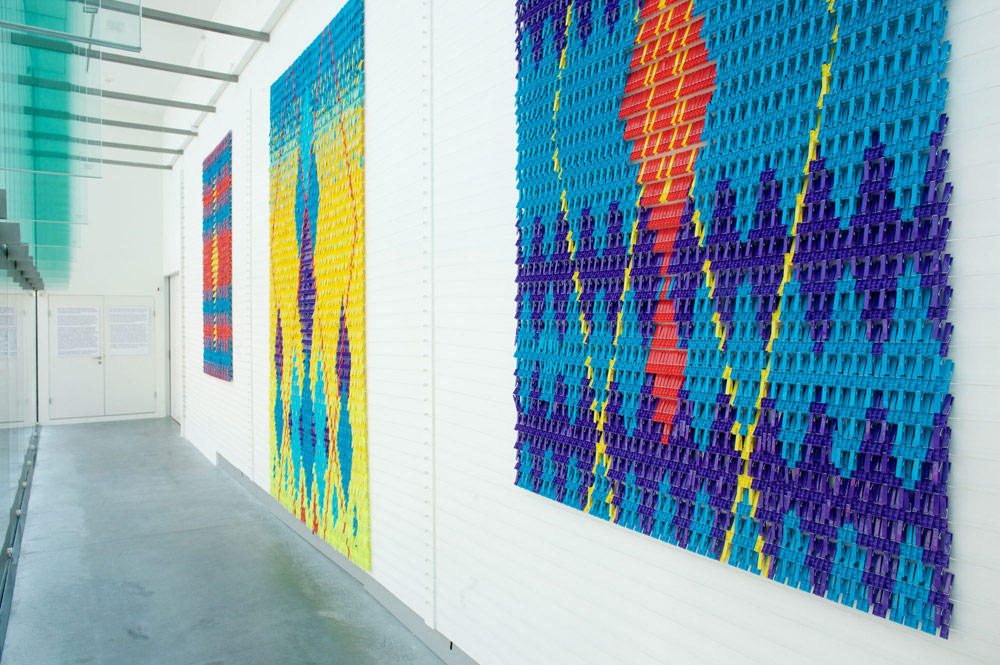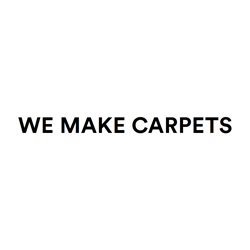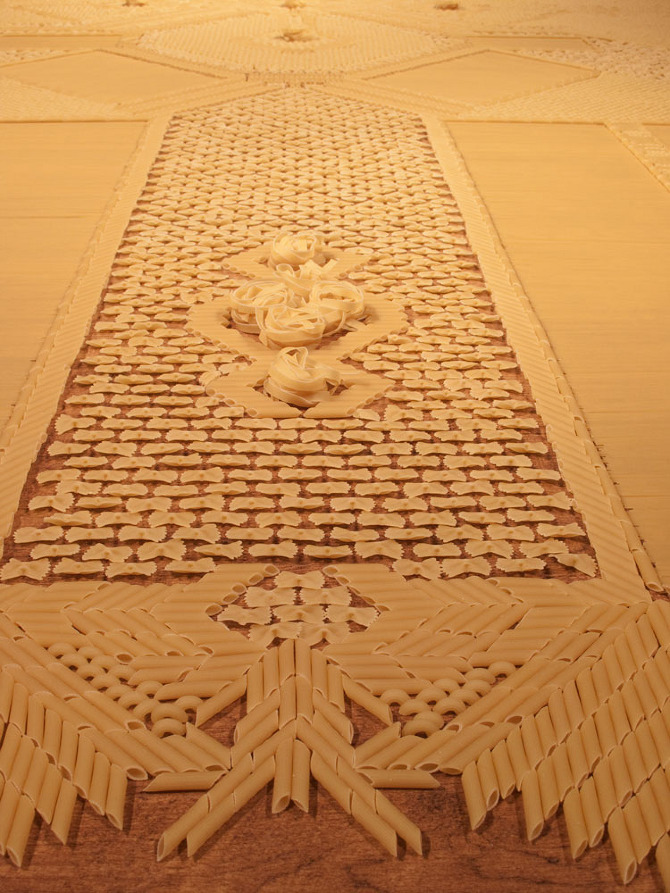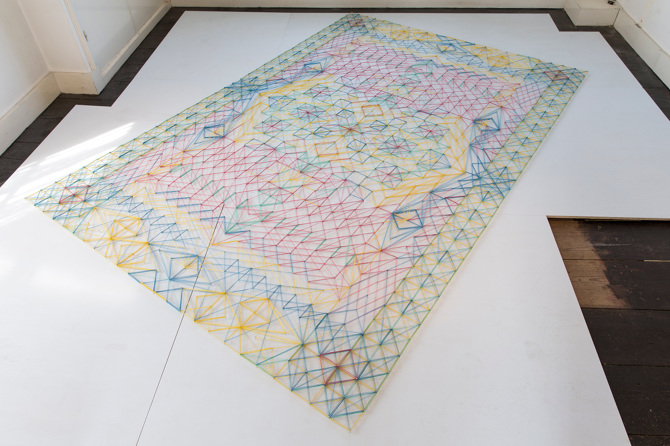Everyday objects and materials site-specific art installations

Behind the carpet
WE MAKE CARPETS does not make carpets. At least, no carpets to walk on. A visitor already walked over to Fork Carpet during the Dutch Design Week in 2010.
The carpets are also not suitable to touch. But that sometimes happens. Suddenly there was a fingerprint in ‘Muisjes’ Carpet. And a visitor took a bite out of Candybar Carpet.
But tape everything or put a fence around it? New. That doesn’t fit the job. From a distance it looks like a carpet, but you have to be able to get closer to see that they are clothespins. Or any other utensil.
Dutch Design Week
It’s Friday afternoon. Bob, Marcia and Stijn are working on their latest carpet – Led Carpet – in their Amsterdam studio. There are beers. Bob wields a soldering iron. Marcia and Stijn bend iron wires.
The three made their first carpet in 2009. They collaborated on the ‘Instant Nature’ exhibition during the Dutch Design Week. In the forest they collected pine cones and needles. That became Forest Carpet. I liked the shape and six carpets followed to further develop the collaboration. ‘There was never a preconceived plan, like ‘we are now going to make carpets with the three of us’. That went without saying. At the same time, we felt it could go somewhere.’

Streamer Carpet & Skewer Carpet, MU Eindhoven 2014 (© Boudewijn Bollmann)
This is how the carpets are created: naturally. There is no design. The material, location and size are fixed, but otherwise they work intuitively. Who wants to start. In the middle. Then follow long days on the knees or in other awkward positions. Often late into the night. ‘There’s something meditative about it. We work as a unit, always the three of us and hardly ever take breaks.’
Trucks
This method sometimes takes its toll. Brick Carpet was their first paid assignment. It was a large outdoor work of twenty by thirty meters. Two trucks full of bricks arrived. “That dump was really cool.” But the six days of sorting and laying that followed left Marcia inflamed with tendonitis. “My wrists cracked. Literally.’
‘That physicality is one thing,’ they say. The large works are heavy, but the small ones may be more intense. Marcia: ‘Then your whole body is under tension. I was working on ‘Muisjes’ Carpet, a tiny carpet. We had been on it for several days. I don’t remember exactly what happened, I probably bumped into something. That was the last straw. I yelled “I can’t do it anymore”, and fell through my legs.’
That work is part of it. It’s even a condition, they explain. ‘Each carpet is symmetrical. There’s a pattern to it. You have to put that down and that takes time.’ Moreover, it is precisely this work and the vulnerability of the works that raise questions in the visitor’s mind. Did you put all that down? How long does it take you now? How many are there actually? Can you walk over it?
That surprise is about the material. And that’s what WE MAKE CARPETS is all about. “We want people to look at those products again. That they become aware of its beauty. You don’t buy a paper clip because it’s beautiful, but it is.’
The collective shares that fascination for everyday archetypal products. ‘We like shape. From simplicity. All three of us are not expressionistic in our way of working, maybe that’s what binds us together.’

Peg Carpet, Graphic Design Museum 2011 (© Boudewijn Bollman)
Tinkering with Led Carpet, they almost lean against each other, but don’t get in each other’s way for a moment. There is a natural self-evidence in their collaboration. Almost without communicating, Stijn and Marcia move the jumble of lights and wires. Bob plugs in the electricity. The carpet works.
Pasta
WE MAKE CARPETS is more than the sum of its parts. The synergy of the trio is striking. As they work, so they talk. Sentences are completed by another halfway through. If Bob takes a side road in the conversation, Stijn returns to the original topic. Together they form their answers.
Bob: ‘Our work is about super elementary design. It is about objects that everyone uses, such as pegs and LEDs, but which are no longer thought about. Why does it look like this?’ Stijn adds: ‘It is actually a revaluation of materials that are made to be thrown away.’ Later, Marcia says: ‘For us it’s all about the form. It’s very minimalistic.’
In the hands of the collective, utensils acquire a new value. Pasta is no longer pasta. ‘It’s our material,’ they emphasize. That is leading. Do you work with clothespins? Then you get a diamond. Are there more yellow chips than green forks? Then that determines the pattern.
It brings the trio into strange conversations with suppliers. Can you deliver those party hats not in blue, but in silver? Is the inside of that serpentine colored too? ‘Then you hear such a man think, “What difference does it make? What kind of party are those people throwing?”’
WE MAKE CARPETS loves those materials. ‘We want to celebrate that those products exist.’

Pencil Carpet, Jerusalem Design Week 2017 (© WMC)

Pencil Carpet, Jerusalem Design Week 2017 (© WMC)

Sponge Carpet 2, National Gallery Victoria 2017 (© WMC)

Sponge Carpet 2, National Gallery Victoria 2017 (© WMC)
Brick carpet & Forest carpet
Pasta carpet & Bottle carpet
Confetti carpets & Rubberband carpet
We Make Carpets, Netherlands

PROFILE
“We Make Carpets” is a Dutch collective that transforms everyday objects into beautiful carpets for art installations. Their philosophy is that mass-produced objects are often thrown away without a thought when they have served their usefulness. Their art carpets turn massive quantities of everyday objects such as scouring sponges, forks, and dishes into beautiful rugs for display.
Main Research Source
Materials for the Arts, New York, suggest using We Make Carpets as inspiration for creating Fractal Carpets.
“Using any large quantity of a repetitive object (take out utensils, straws, dominos, pattern blocks, stale pasta) you can make a fractal carpet. This can be a one time activity, an activity that you work on for multiple days, a temporary activity or by glueing it all down you can make it permanent. Not only is this a great way to see, grow and change patterns, but it’s also a soothing, meditative activity for calm-down or quiet times.”
Suggested Reused Materials: Paper, card stock or cereal boxes, fabric, glue, scissors













